FORD C MAX 2013 Owners Manual
Manufacturer: FORD, Model Year: 2013, Model line: C MAX, Model: FORD C MAX 2013Pages: 552, PDF Size: 8.55 MB
Page 201 of 552
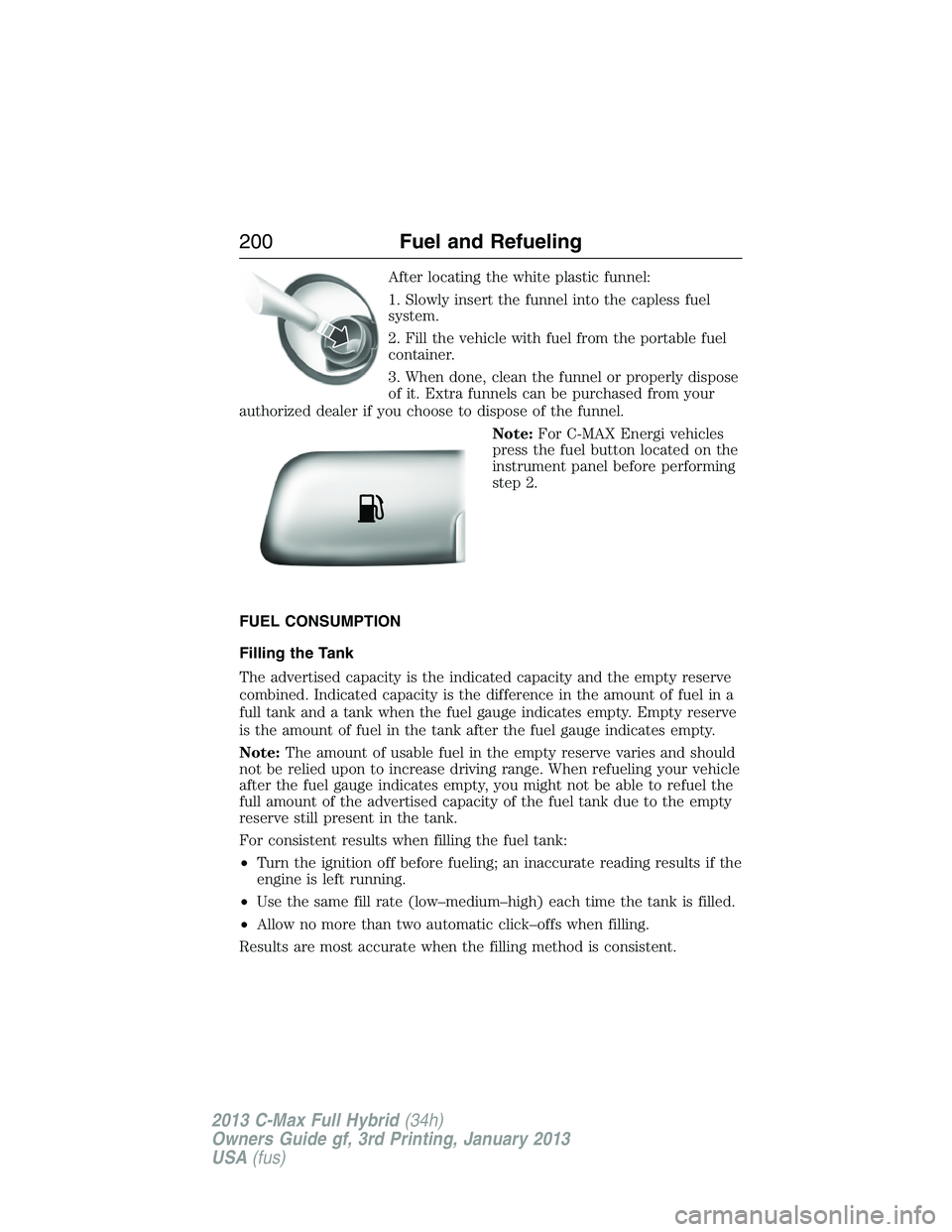
After locating the white plastic funnel:
1. Slowly insert the funnel into the capless fuel
system.
2. Fill the vehicle with fuel from the portable fuel
container.
3. When done, clean the funnel or properly dispose
of it. Extra funnels can be purchased from your
authorized dealer if you choose to dispose of the funnel.
Note:For C-MAX Energi vehicles
press the fuel button located on the
instrument panel before performing
step 2.
FUEL CONSUMPTION
Filling the Tank
The advertised capacity is the indicated capacity and the empty reserve
combined. Indicated capacity is the difference in the amount of fuel in a
full tank and a tank when the fuel gauge indicates empty. Empty reserve
is the amount of fuel in the tank after the fuel gauge indicates empty.
Note:The amount of usable fuel in the empty reserve varies and should
not be relied upon to increase driving range. When refueling your vehicle
after the fuel gauge indicates empty, you might not be able to refuel the
full amount of the advertised capacity of the fuel tank due to the empty
reserve still present in the tank.
For consistent results when filling the fuel tank:
•Turn the ignition off before fueling; an inaccurate reading results if the
engine is left running.
•Use the same fill rate (low–medium–high) each time the tank is filled.
•Allow no more than two automatic click–offs when filling.
Results are most accurate when the filling method is consistent.
200Fuel and Refueling
2013 C-Max Full Hybrid(34h)
Owners Guide gf, 3rd Printing, January 2013
USA(fus)
Page 202 of 552
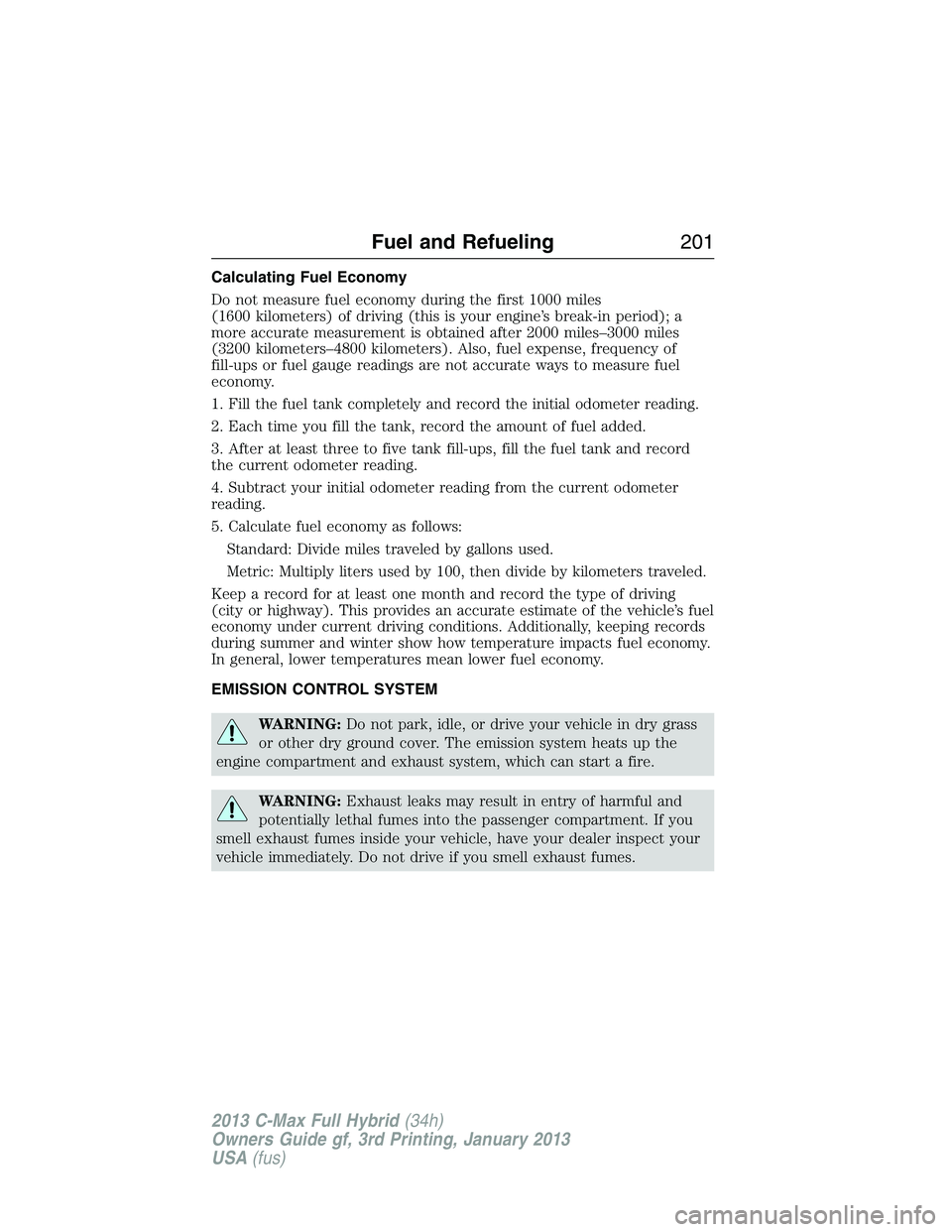
Calculating Fuel Economy
Do not measure fuel economy during the first 1000 miles
(1600 kilometers) of driving (this is your engine’s break-in period); a
more accurate measurement is obtained after 2000 miles–3000 miles
(3200 kilometers–4800 kilometers). Also, fuel expense, frequency of
fill-ups or fuel gauge readings are not accurate ways to measure fuel
economy.
1. Fill the fuel tank completely and record the initial odometer reading.
2. Each time you fill the tank, record the amount of fuel added.
3. After at least three to five tank fill-ups, fill the fuel tank and record
the current odometer reading.
4. Subtract your initial odometer reading from the current odometer
reading.
5. Calculate fuel economy as follows:
Standard: Divide miles traveled by gallons used.
Metric: Multiply liters used by 100, then divide by kilometers traveled.
Keep a record for at least one month and record the type of driving
(city or highway). This provides an accurate estimate of the vehicle’s fuel
economy under current driving conditions. Additionally, keeping records
during summer and winter show how temperature impacts fuel economy.
In general, lower temperatures mean lower fuel economy.
EMISSION CONTROL SYSTEM
WARNING:Do not park, idle, or drive your vehicle in dry grass
or other dry ground cover. The emission system heats up the
engine compartment and exhaust system, which can start a fire.
WARNING:Exhaust leaks may result in entry of harmful and
potentially lethal fumes into the passenger compartment. If you
smell exhaust fumes inside your vehicle, have your dealer inspect your
vehicle immediately. Do not drive if you smell exhaust fumes.
Fuel and Refueling201
2013 C-Max Full Hybrid(34h)
Owners Guide gf, 3rd Printing, January 2013
USA(fus)
Page 203 of 552
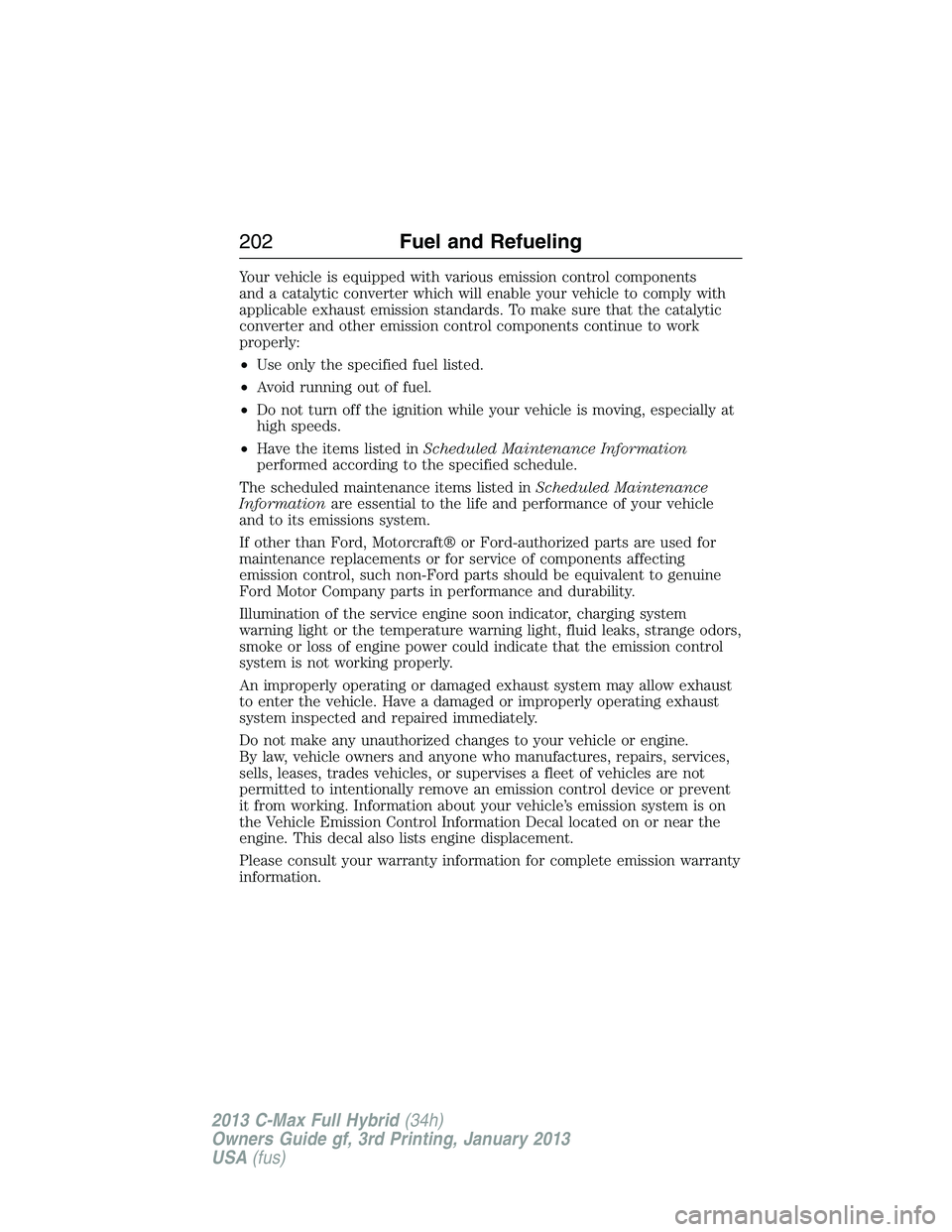
Your vehicle is equipped with various emission control components
and a catalytic converter which will enable your vehicle to comply with
applicable exhaust emission standards. To make sure that the catalytic
converter and other emission control components continue to work
properly:
•Use only the specified fuel listed.
•Avoid running out of fuel.
•Do not turn off the ignition while your vehicle is moving, especially at
high speeds.
•Have the items listed inScheduled Maintenance Information
performed according to the specified schedule.
The scheduled maintenance items listed inScheduled Maintenance
Informationare essential to the life and performance of your vehicle
and to its emissions system.
If other than Ford, Motorcraft® or Ford-authorized parts are used for
maintenance replacements or for service of components affecting
emission control, such non-Ford parts should be equivalent to genuine
Ford Motor Company parts in performance and durability.
Illumination of the service engine soon indicator, charging system
warning light or the temperature warning light, fluid leaks, strange odors,
smoke or loss of engine power could indicate that the emission control
system is not working properly.
An improperly operating or damaged exhaust system may allow exhaust
to enter the vehicle. Have a damaged or improperly operating exhaust
system inspected and repaired immediately.
Do not make any unauthorized changes to your vehicle or engine.
By law, vehicle owners and anyone who manufactures, repairs, services,
sells, leases, trades vehicles, or supervises a fleet of vehicles are not
permitted to intentionally remove an emission control device or prevent
it from working. Information about your vehicle’s emission system is on
the Vehicle Emission Control Information Decal located on or near the
engine. This decal also lists engine displacement.
Please consult your warranty information for complete emission warranty
information.
202Fuel and Refueling
2013 C-Max Full Hybrid(34h)
Owners Guide gf, 3rd Printing, January 2013
USA(fus)
Page 204 of 552
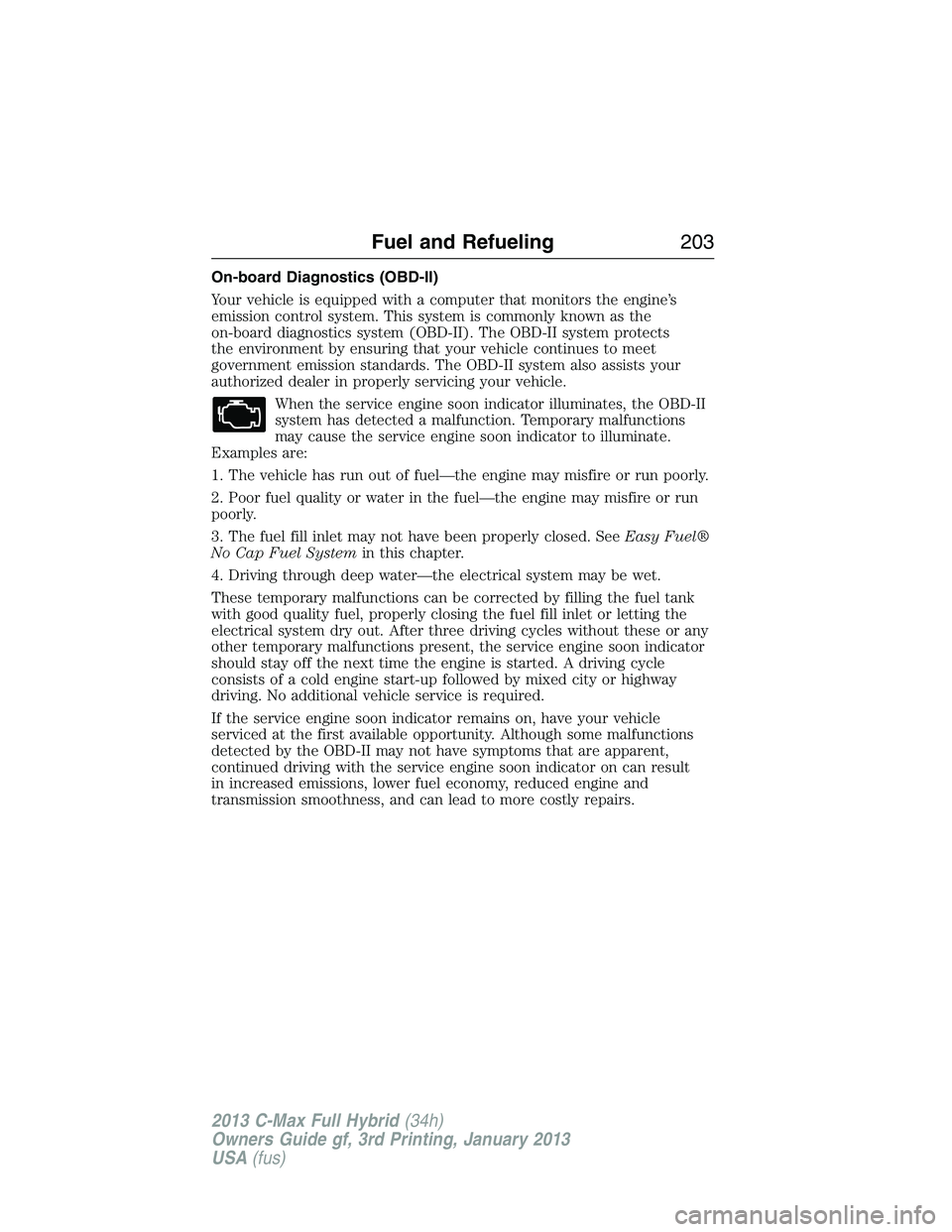
On-board Diagnostics (OBD-II)
Your vehicle is equipped with a computer that monitors the engine’s
emission control system. This system is commonly known as the
on-board diagnostics system (OBD-II). The OBD-II system protects
the environment by ensuring that your vehicle continues to meet
government emission standards. The OBD-II system also assists your
authorized dealer in properly servicing your vehicle.
When the service engine soon indicator illuminates, the OBD-II
system has detected a malfunction. Temporary malfunctions
may cause the service engine soon indicator to illuminate.
Examples are:
1. The vehicle has run out of fuel—the engine may misfire or run poorly.
2. Poor fuel quality or water in the fuel—the engine may misfire or run
poorly.
3. The fuel fill inlet may not have been properly closed. SeeEasy Fuel®
No Cap Fuel Systemin this chapter.
4. Driving through deep water—the electrical system may be wet.
These temporary malfunctions can be corrected by filling the fuel tank
with good quality fuel, properly closing the fuel fill inlet or letting the
electrical system dry out. After three driving cycles without these or any
other temporary malfunctions present, the service engine soon indicator
should stay off the next time the engine is started. A driving cycle
consists of a cold engine start-up followed by mixed city or highway
driving. No additional vehicle service is required.
If the service engine soon indicator remains on, have your vehicle
serviced at the first available opportunity. Although some malfunctions
detected by the OBD-II may not have symptoms that are apparent,
continued driving with the service engine soon indicator on can result
in increased emissions, lower fuel economy, reduced engine and
transmission smoothness, and can lead to more costly repairs.
Fuel and Refueling203
2013 C-Max Full Hybrid(34h)
Owners Guide gf, 3rd Printing, January 2013
USA(fus)
Page 205 of 552
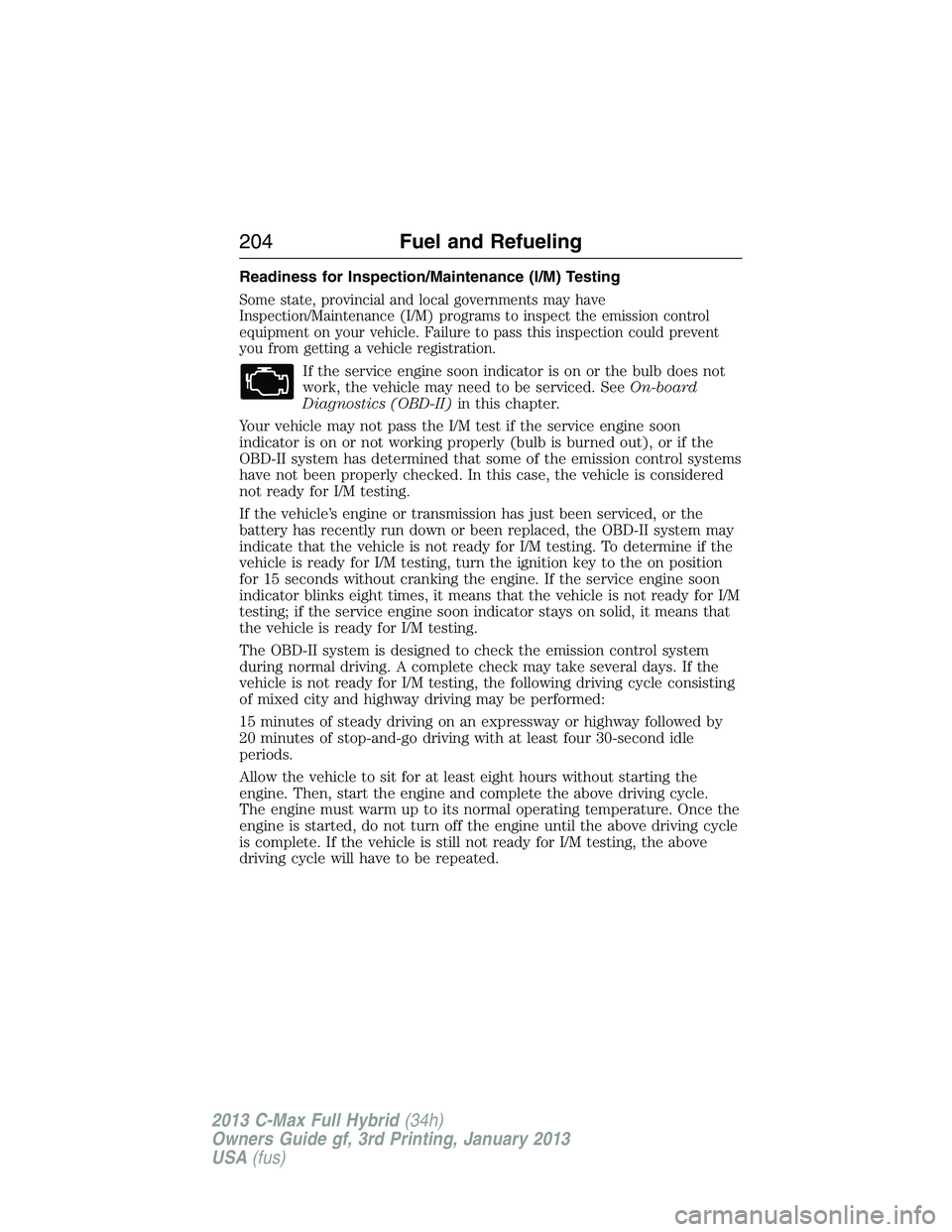
Readiness for Inspection/Maintenance (I/M) Testing
Some state, provincial and local governments may have
Inspection/Maintenance (I/M) programs to inspect the emission control
equipment on your vehicle. Failure to pass this inspection could prevent
you from getting a vehicle registration.
If the service engine soon indicator is on or the bulb does not
work, the vehicle may need to be serviced. SeeOn-board
Diagnostics (OBD-II)in this chapter.
Your vehicle may not pass the I/M test if the service engine soon
indicator is on or not working properly (bulb is burned out), or if the
OBD-II system has determined that some of the emission control systems
have not been properly checked. In this case, the vehicle is considered
not ready for I/M testing.
If the vehicle’s engine or transmission has just been serviced, or the
battery has recently run down or been replaced, the OBD-II system may
indicate that the vehicle is not ready for I/M testing. To determine if the
vehicle is ready for I/M testing, turn the ignition key to the on position
for 15 seconds without cranking the engine. If the service engine soon
indicator blinks eight times, it means that the vehicle is not ready for I/M
testing; if the service engine soon indicator stays on solid, it means that
the vehicle is ready for I/M testing.
The OBD-II system is designed to check the emission control system
during normal driving. A complete check may take several days. If the
vehicle is not ready for I/M testing, the following driving cycle consisting
of mixed city and highway driving may be performed:
15 minutes of steady driving on an expressway or highway followed by
20 minutes of stop-and-go driving with at least four 30-second idle
periods.
Allow the vehicle to sit for at least eight hours without starting the
engine. Then, start the engine and complete the above driving cycle.
The engine must warm up to its normal operating temperature. Once the
engine is started, do not turn off the engine until the above driving cycle
is complete. If the vehicle is still not ready for I/M testing, the above
driving cycle will have to be repeated.
204Fuel and Refueling
2013 C-Max Full Hybrid(34h)
Owners Guide gf, 3rd Printing, January 2013
USA(fus)
Page 206 of 552
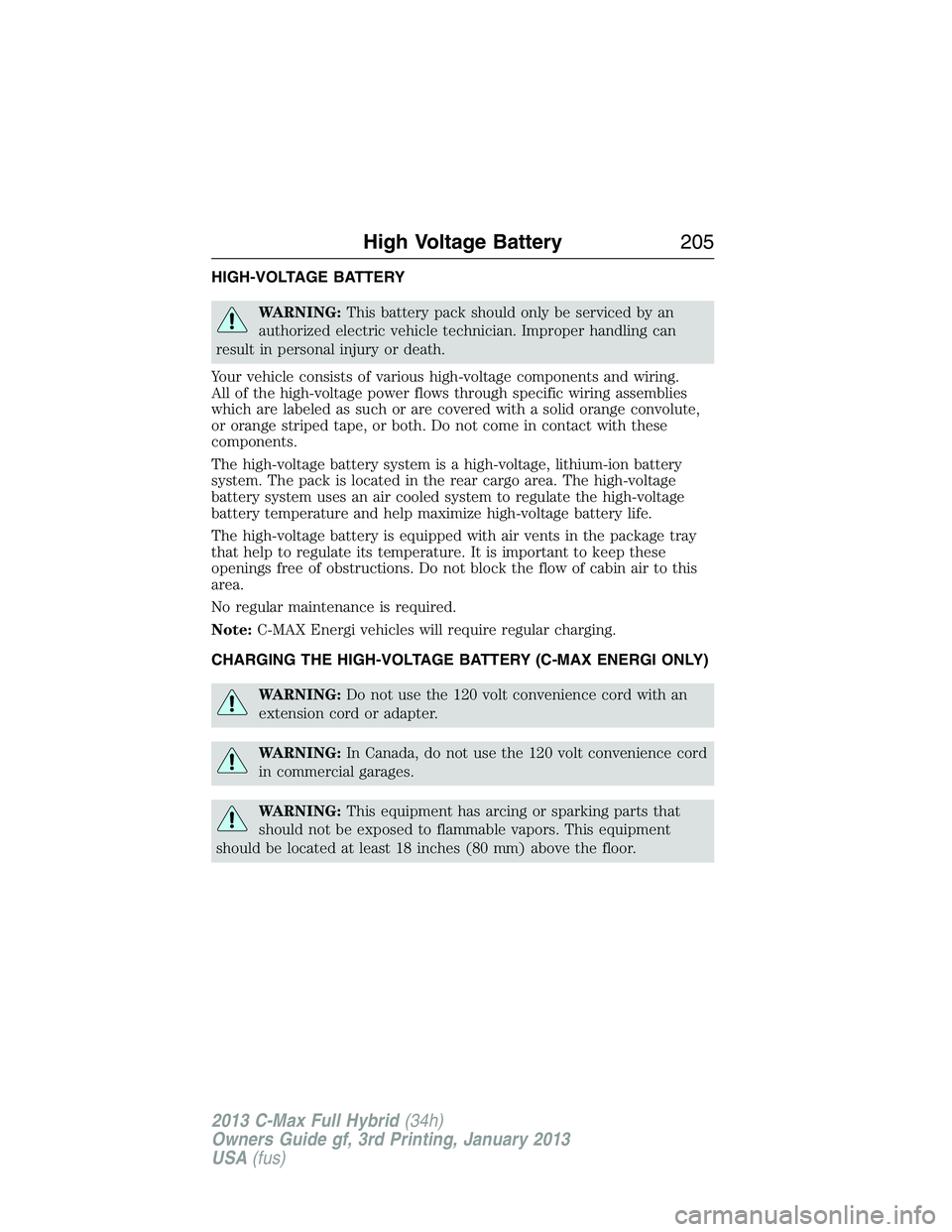
HIGH-VOLTAGE BATTERY
WARNING:This battery pack should only be serviced by an
authorized electric vehicle technician. Improper handling can
result in personal injury or death.
Your vehicle consists of various high-voltage components and wiring.
All of the high-voltage power flows through specific wiring assemblies
which are labeled as such or are covered with a solid orange convolute,
or orange striped tape, or both. Do not come in contact with these
components.
The high-voltage battery system is a high-voltage, lithium-ion battery
system. The pack is located in the rear cargo area. The high-voltage
battery system uses an air cooled system to regulate the high-voltage
battery temperature and help maximize high-voltage battery life.
The high-voltage battery is equipped with air vents in the package tray
that help to regulate its temperature. It is important to keep these
openings free of obstructions. Do not block the flow of cabin air to this
area.
No regular maintenance is required.
Note:C-MAX Energi vehicles will require regular charging.
CHARGING THE HIGH-VOLTAGE BATTERY (C-MAX ENERGI ONLY)
WARNING:Do not use the 120 volt convenience cord with an
extension cord or adapter.
WARNING:In Canada, do not use the 120 volt convenience cord
in commercial garages.
WARNING:This equipment has arcing or sparking parts that
should not be exposed to flammable vapors. This equipment
should be located at least 18 inches (80 mm) above the floor.
High Voltage Battery205
2013 C-Max Full Hybrid(34h)
Owners Guide gf, 3rd Printing, January 2013
USA(fus)
Page 207 of 552
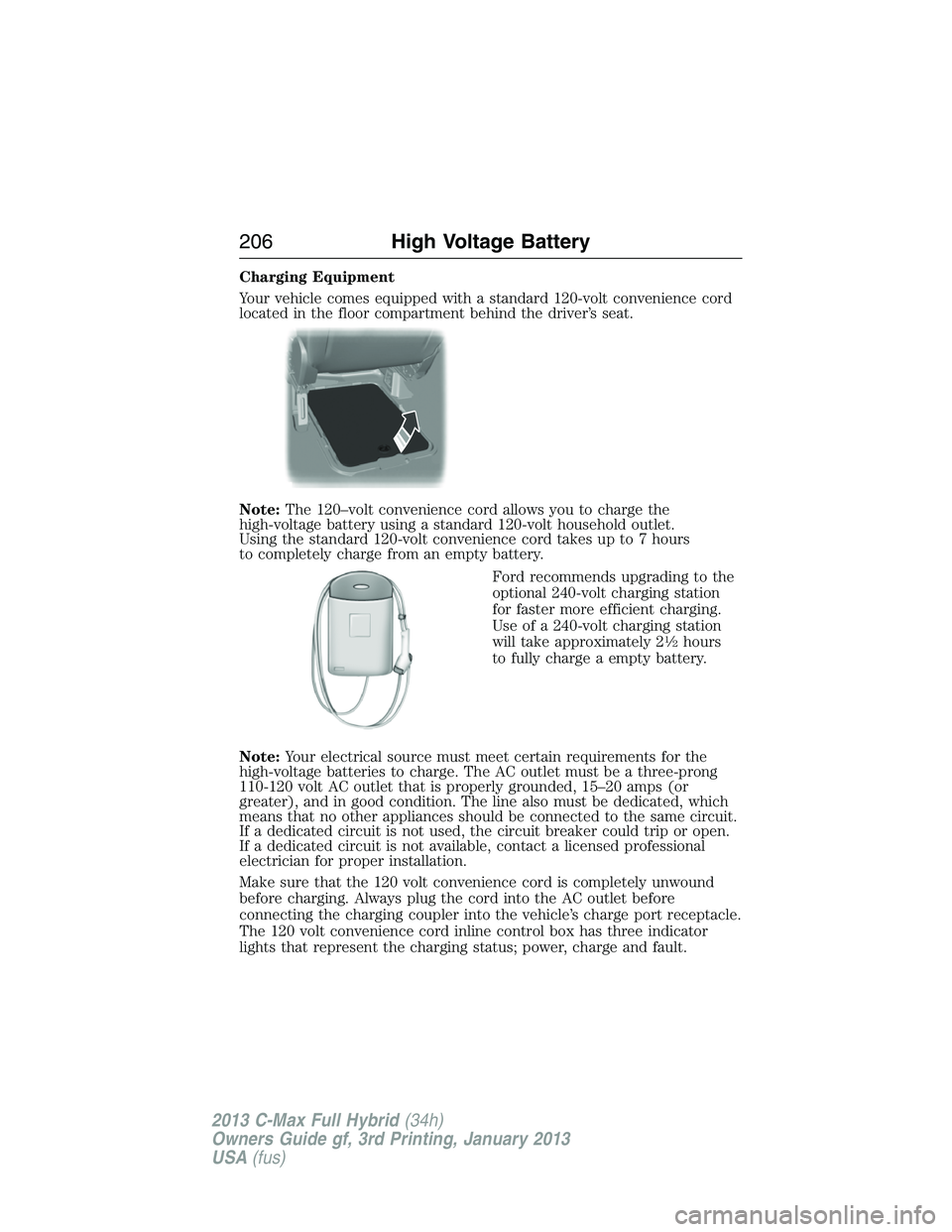
Charging Equipment
Your vehicle comes equipped with a standard 120-volt convenience cord
located in the floor compartment behind the driver’s seat.
Note:The 120–volt convenience cord allows you to charge the
high-voltage battery using a standard 120-volt household outlet.
Using the standard 120-volt convenience cord takes up to 7 hours
to completely charge from an empty battery.
Ford recommends upgrading to the
optional 240-volt charging station
for faster more efficient charging.
Use of a 240-volt charging station
will take approximately 2
1�2hours
to fully charge a empty battery.
Note:Your electrical source must meet certain requirements for the
high-voltage batteries to charge. The AC outlet must be a three-prong
110-120 volt AC outlet that is properly grounded, 15–20 amps (or
greater), and in good condition. The line also must be dedicated, which
means that no other appliances should be connected to the same circuit.
If a dedicated circuit is not used, the circuit breaker could trip or open.
If a dedicated circuit is not available, contact a licensed professional
electrician for proper installation.
Make sure that the 120 volt convenience cord is completely unwound
before charging. Always plug the cord into the AC outlet before
connecting the charging coupler into the vehicle’s charge port receptacle.
The 120 volt convenience cord inline control box has three indicator
lights that represent the charging status; power, charge and fault.
206High Voltage Battery
2013 C-Max Full Hybrid(34h)
Owners Guide gf, 3rd Printing, January 2013
USA(fus)
Page 208 of 552
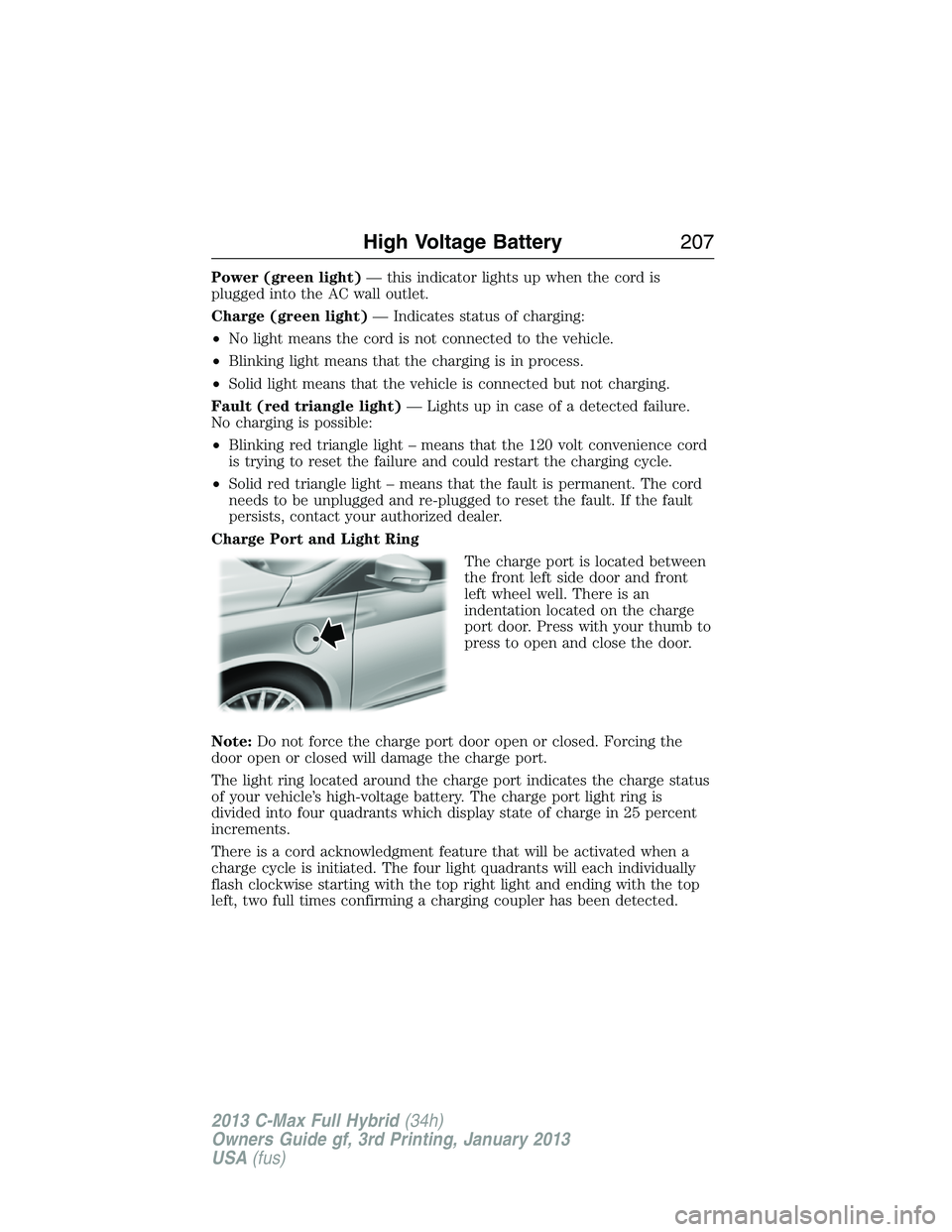
Power (green light)— this indicator lights up when the cord is
plugged into the AC wall outlet.
Charge (green light)— Indicates status of charging:
•No light means the cord is not connected to the vehicle.
•Blinking light means that the charging is in process.
•Solid light means that the vehicle is connected but not charging.
Fault (red triangle light)— Lights up in case of a detected failure.
No charging is possible:
•Blinking red triangle light – means that the 120 volt convenience cord
is trying to reset the failure and could restart the charging cycle.
•Solid red triangle light – means that the fault is permanent. The cord
needs to be unplugged and re-plugged to reset the fault. If the fault
persists, contact your authorized dealer.
Charge Port and Light Ring
The charge port is located between
the front left side door and front
left wheel well. There is an
indentation located on the charge
port door. Press with your thumb to
press to open and close the door.
Note:Do not force the charge port door open or closed. Forcing the
door open or closed will damage the charge port.
The light ring located around the charge port indicates the charge status
of your vehicle’s high-voltage battery. The charge port light ring is
divided into four quadrants which display state of charge in 25 percent
increments.
There is a cord acknowledgment feature that will be activated when a
charge cycle is initiated. The four light quadrants will each individually
flash clockwise starting with the top right light and ending with the top
left, two full times confirming a charging coupler has been detected.
High Voltage Battery207
2013 C-Max Full Hybrid(34h)
Owners Guide gf, 3rd Printing, January 2013
USA(fus)
Page 209 of 552
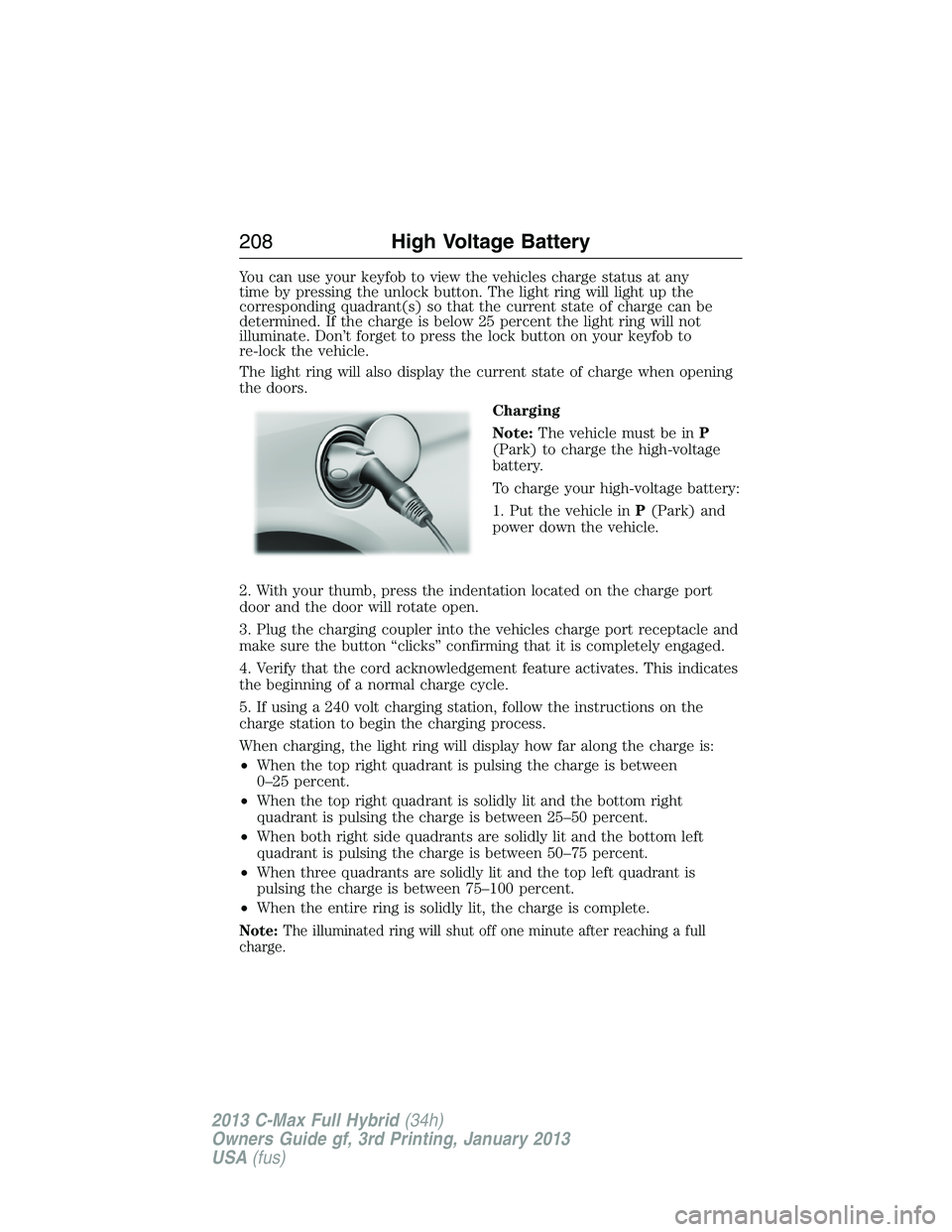
You can use your keyfob to view the vehicles charge status at any
time by pressing the unlock button. The light ring will light up the
corresponding quadrant(s) so that the current state of charge can be
determined. If the charge is below 25 percent the light ring will not
illuminate. Don’t forget to press the lock button on your keyfob to
re-lock the vehicle.
The light ring will also display the current state of charge when opening
the doors.
Charging
Note:The vehicle must be inP
(Park) to charge the high-voltage
battery.
To charge your high-voltage battery:
1. Put the vehicle inP(Park) and
power down the vehicle.
2. With your thumb, press the indentation located on the charge port
door and the door will rotate open.
3. Plug the charging coupler into the vehicles charge port receptacle and
make sure the button “clicks” confirming that it is completely engaged.
4. Verify that the cord acknowledgement feature activates. This indicates
the beginning of a normal charge cycle.
5. If using a 240 volt charging station, follow the instructions on the
charge station to begin the charging process.
When charging, the light ring will display how far along the charge is:
•When the top right quadrant is pulsing the charge is between
0–25 percent.
•When the top right quadrant is solidly lit and the bottom right
quadrant is pulsing the charge is between 25–50 percent.
•When both right side quadrants are solidly lit and the bottom left
quadrant is pulsing the charge is between 50–75 percent.
•When three quadrants are solidly lit and the top left quadrant is
pulsing the charge is between 75–100 percent.
•When the entire ring is solidly lit, the charge is complete.
Note:The illuminated ring will shut off one minute after reaching a full
charge.
208High Voltage Battery
2013 C-Max Full Hybrid(34h)
Owners Guide gf, 3rd Printing, January 2013
USA(fus)
Page 210 of 552
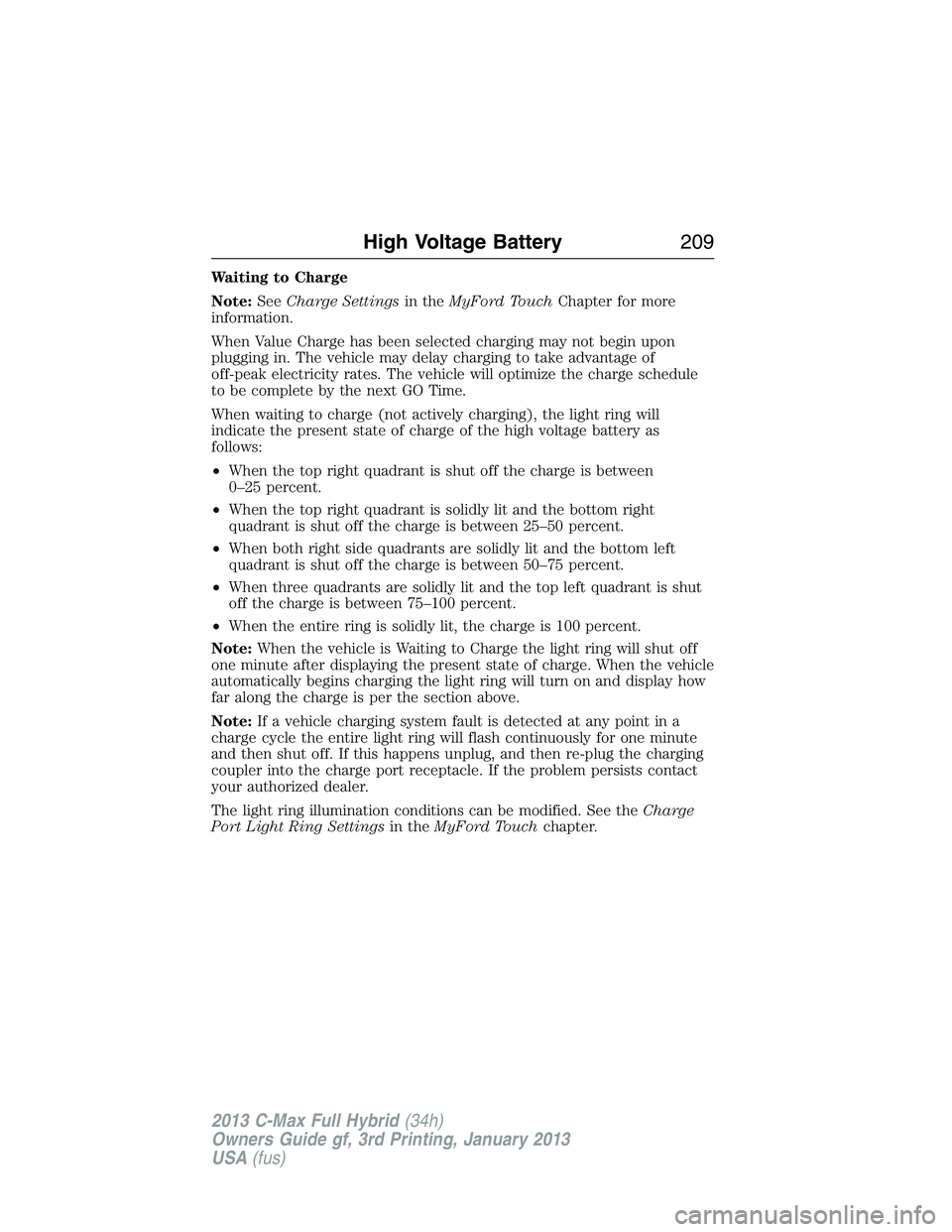
Waiting to Charge
Note:SeeCharge Settingsin theMyFord TouchChapter for more
information.
When Value Charge has been selected charging may not begin upon
plugging in. The vehicle may delay charging to take advantage of
off-peak electricity rates. The vehicle will optimize the charge schedule
to be complete by the next GO Time.
When waiting to charge (not actively charging), the light ring will
indicate the present state of charge of the high voltage battery as
follows:
•When the top right quadrant is shut off the charge is between
0–25 percent.
•When the top right quadrant is solidly lit and the bottom right
quadrant is shut off the charge is between 25–50 percent.
•When both right side quadrants are solidly lit and the bottom left
quadrant is shut off the charge is between 50–75 percent.
•When three quadrants are solidly lit and the top left quadrant is shut
off the charge is between 75–100 percent.
•When the entire ring is solidly lit, the charge is 100 percent.
Note:When the vehicle is Waiting to Charge the light ring will shut off
one minute after displaying the present state of charge. When the vehicle
automatically begins charging the light ring will turn on and display how
far along the charge is per the section above.
Note:If a vehicle charging system fault is detected at any point in a
charge cycle the entire light ring will flash continuously for one minute
and then shut off. If this happens unplug, and then re-plug the charging
coupler into the charge port receptacle. If the problem persists contact
your authorized dealer.
The light ring illumination conditions can be modified. See theCharge
Port Light Ring Settingsin theMyFord Touchchapter.
High Voltage Battery209
2013 C-Max Full Hybrid(34h)
Owners Guide gf, 3rd Printing, January 2013
USA(fus)